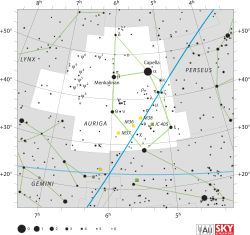| Observation data Epoch J2000 Equinox J2000 | |
|---|---|
| Constellation | Auriga |
| Right ascension | 05h 32m 43.67437s[1] |
| Declination | +32° 11′ 31.2805″[1] |
| Apparent magnitude (V) | 4.74[2] |
| Characteristics | |
| Spectral type | B5 Iab[3] |
| U−B color index | –0.44[2] |
| B−V color index | +0.32[2] |
| Astrometry | |
| Radial velocity (Rv) | –0.2[4] km/s |
| Proper motion (μ) | RA: −0.812 mas/yr[1] Dec.: −3.15 mas/yr[1] |
| Parallax (π) | 0.9087 ± 0.1906 mas[1] |
| Distance | 3910±420 ly (1,200±130 pc)[5] |
| Absolute magnitude (MV) | –6.4[6] |
| Orbit[6] | |
| Period (P) | 676.85 ± 0.21 d |
| Eccentricity (e) | 0.116 ± 0.048 |
| Longitude of the node (Ω) | 181.7° ± 24.3° |
| Periastron epoch (T) | 2422754.2 ± 46.1 HJD |
| Semi-amplitude (K1) (primary) | 22.0 ± 2.9 km/s |
| Details | |
| Mass | 21.1±0.2[5] M☉ |
| Radius | 68±8[5] R☉ |
| Luminosity | 190,500+49,300 −39,200[5] L☉ |
| Surface gravity (log g) | 2.11±0.06[5] cgs |
| Temperature | 14,600±300[5] K |
| Rotational velocity (v sin i) | 40[7] km/s |
| Age | 8.7[5] Myr |
| Other designations | |
| Database references | |
| SIMBAD | data |
Chi Aurigae, Latinized from χ Aurigae, is the Bayer designation for a binary star system in the northern constellation of Auriga. It is visible to the naked eye with an apparent visual magnitude of 4.74.[2] The distance of Chi Aurigae is determined at 3,900 ly based on spectroscopic observations.[5] Parallax measurements by the Hipparcos spacecraft were unsuccessful because the parallax error was bigger than the value itself,[9] while the Gaia spacecraft measured the parallax with a 22% error, giving a distance of 3590±750 ly.[1] The brightness of the star is diminished by 1.26 in magnitude from extinction caused by intervening gas and dust.[6]
Chi Aurigae is a spectroscopic binary with an orbital period of 676.85 d and an eccentricity of 0.12.[10] The primary component of this system is a supergiant star with a stellar classification of B5 Iab.[3] It is over 190,000 times more luminous, around 20 times more massive and around 70 times larger. Its surface has an effective temperature of 14,600 K.[5] It has a stellar wind that is causing mass loss at the rate of 0.38–0.46 × 10−9 solar masses per year, or the equivalent of the Sun's mass every 2.4 billion years.[11]
- ^ a b c d e Cite error: The named reference
DR3was invoked but never defined (see the help page). - ^ a b c d Cite error: The named reference
aj76_1058was invoked but never defined (see the help page). - ^ a b Cite error: The named reference
apjs17_371was invoked but never defined (see the help page). - ^ Cite error: The named reference
gcsrvwas invoked but never defined (see the help page). - ^ a b c d e f g h i Cite error: The named reference
quantitativewas invoked but never defined (see the help page). - ^ a b c Cite error: The named reference
aaa331_550was invoked but never defined (see the help page). - ^ Cite error: The named reference
apj573_1_359was invoked but never defined (see the help page). - ^ Cite error: The named reference
SIMBADwas invoked but never defined (see the help page). - ^ Cite error: The named reference
aaa474_2_653was invoked but never defined (see the help page). - ^ Cite error: The named reference
aaa424_2_727was invoked but never defined (see the help page). - ^ Cite error: The named reference
aaa521_L55was invoked but never defined (see the help page).
